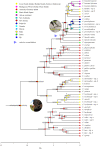Habitat preference modulates trans-oceanic dispersal in a terrestrial vertebrate
- PMID: 31161911
- PMCID: PMC6571479
- DOI: 10.1098/rspb.2018.2575
Habitat preference modulates trans-oceanic dispersal in a terrestrial vertebrate
Abstract
The importance of long-distance dispersal (LDD) in shaping geographical distributions has been debated since the nineteenth century. In terrestrial vertebrates, LDD events across large water bodies are considered highly improbable, but organismal traits affecting dispersal capacity are generally not taken into account. Here, we focus on a recent lizard radiation and combine a summary-coalescent species tree based on 1225 exons with a probabilistic model that links dispersal capacity to an evolving trait, to investigate whether ecological specialization has influenced the probability of trans-oceanic dispersal. Cryptoblepharus species that occur in coastal habitats have on average dispersed 13 to 14 times more frequently than non-coastal species and coastal specialization has, therefore, led to an extraordinarily widespread distribution that includes multiple continents and distant island archipelagoes. Furthermore, their presence across the Pacific substantially predates the age of human colonization and we can explicitly reject the possibility that these patterns are solely shaped by human-mediated dispersal. Overall, by combining new analytical methods with a comprehensive phylogenomic dataset, we use a quantitative framework to show how coastal specialization can influence dispersal capacity and eventually shape geographical distributions at a macroevolutionary scale.
Keywords: Cryptoblepharus; biogeography; exon capture; long-distance dispersal.
Conflict of interest statement
The authors declare no competing interests.
Figures


References
-
- Darwin C. 1859. On the origin of species by means of natural selection. London, UK: John Murray.
-
- Heads M. 2014. Biogeography by revelation: investigating a world shaped by miracles. Aust. Syst. Bot. 27, 282–304. (10.1071/SB14038) - DOI
Publication types
MeSH terms
Associated data
LinkOut - more resources
Full Text Sources
Other Literature Sources

